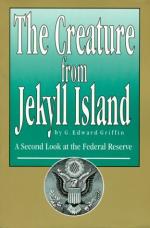
|
| Name: _________________________ | Period: ___________________ |
This quiz consists of 5 multiple choice and 5 short answer questions through Section I. What Creature Is This? Chapters 5-6 Nearer to the Heart's Desire; Building the New World Order.
Multiple Choice Questions
1. What did the author feel was the ultimate goal in establishing the IMF and the World Bank?
(a) The ultimate goal was to establish the Euro as the single world currency.
(b) The ultimate goal was to put the United Nations in control of world currency.
(c) The ultimate goal was to establish the US dollar as the single world currency.
(d) The ultimate goal was to bring about a single world government that had control of all currencies.
2. How does a currency drain occur within the banking system?
(a) A currency drain happened when many depositors wrote checks, and the receivers of the checks cashed them at another bank, thereby requiring more money from the first bank than it had on hand.
(b) A currency drain occurs when foreign investors withdrawn their funds from US banks.
(c) A currency drain occurs when the Federal government demands repayment of loans.
(d) A currency drain occurs when the government devalues the currency system.
3. How did unemployment impact the economic problems?
(a) High employment distracted people from looking for homes.
(b) High unemployment compounded this problem, forcing people into foreclosures and drying up the housing market.
(c) High employment made more homes available for sale.
(d) The Federal government was distracted from economic problems and focused their attention on the unemployed.
4. What economic group is hit the hardest by an inflation?
(a) Inflation has been a problem for the rich and poor alike, although it hit the chronically poor harder than anyone.
(b) Inflation damages only the very poor in a society.
(c) Only the middle class is hurt by inflation.
(d) Only the very wealthiest people are hurt by inflation.
5. What happens when the Federal Reserve System prints new money?
(a) When the Federal Reserve System creates new money, it causes the stock market to rally.
(b) When the Federal Reserve System creates new money, it increases the value of the money already in the system.
(c) When the Federal Reserve System creates new money, it improves the overall economy.
(d) When the Federal Reserve System creates new money, it dilutes the value of the money already in the system.
Short Answer Questions
1. How did the Federal Reserve System accomplish the nationalization of banks?
2. What is the definition of a public run on a bank?
3. What was one of the strongest arguments in favor of bank regulation versus nationalization?
4. How did the government provide economic support to Lockheed Corporation in 1970?
5. Since its inception in 1910, the Federal Reserve had made what decisions about bank bailouts?
|
This section contains 774 words (approx. 3 pages at 300 words per page) |

|




